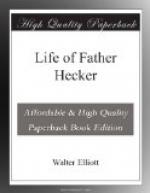Soon after his arrival in Rome he made the acquaintance of George L. Brown, an American artist of some note, and a non-Catholic. He was an earnest man, and Father Hecker attacked him at once on the score of religion, and before December had received him into the Church. This event made quite a stir in Rome. The city was always full of artists and their patrons, and Mr. Brown’s conversion, together with the articles in the Civilta, influenced in Father Hecker’s favor many persons whom he could not directly reach. This was especially the case with the Pope, to whose notice such matters were brought by Archbishop Bedini, his office enabling him to approach the Holy Father at short intervals. He exerted a similar influence on all the high officials of the Roman court.
In spite of all this favor the usual delays attendant upon serious judicial investigations oppressed Father Hecker with the heavy dread of “the law’s delay,” detaining him in Rome from the first week in September, 1857, when the case was opened in the Propaganda, till it was closed by the decision of the Congregation of Bishops and Regulars early in the following March. Nor was the “insolence of office” quite absent. He was once heard to tell of his having been snubbed in the Pope’s antechamber by some one in attendance, and often put aside till he was vexed with many weary hours of waiting and by being compelled to repeatedly return.
“I had to wait for three days,” we read in the memoranda, “and then was reproached and scolded by the monsignor in attendance for coming late. I had not come late but had been kept waiting outside, and I told him so. ‘You will see those hills of Albano move,’ said I, ‘before I move from my purpose to see the Holy Father.’ When he saw my determination he changed and gave me my desired audience.”




